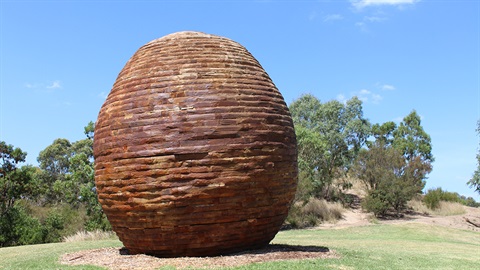Public art collection

Darebin's extensive collection of public art enhancing our urban landscape.
The City of Darebin is home to an extensive Public Art Collection enhancing the urban landscape.
Public art plays an important role in our public spaces as an activator of place, community, and creativity.
Public art offers a tangible way to express and animate our varied stories - our histories, our heritage, the past uses of our land and buildings, a celebration of those people who are important to us, our acknowledgement and appreciation of practices and rituals and issues of relevance to our various communities.
Importantly, public art is free and accessible for all to enjoy, and through our collection Darebin Council hopes to foster innovation, creativity and respect.
Learn more about Darebin's Public Art Collection below:
Do you have questions about public art in Darebin? Read our FAQs below.
FREQUENTLY ASKED QUESTIONS
What is public art?
Public art, art in the public domain, public realm art, urban art, outdoor art – these are all terms for the same thing. Public art is art specifically created to be experienced in the public realm outside the internal walls of a gallery or museum.
What is the difference between permanent public art and temporary public art?
Permanent artworks can be standalone sculptures, 2D or 3D wall pieces, installations, lighting or sound-based works, multi-media pieces or artistic interventions. They can also be artworks integrated into a building or landscape or artist designed outdoor furniture, fittings or decorative elements. They are intended to be in-situ for an extended period of time (usually 15-20 years).
Temporary artworks can encompass artworks in a wide variety of mediums and technologies. The majority of these artworks are developed by the artist specifically for the short term opportunity available. Others may be pre-existing artworks reimagined in a new context. The lifespan of a temporary public artwork or project can range from a few days to a number of months. Ephemeral artworks include performance or event-based pieces that are experiential. They may be fleeting, providing an immediate and momentary experience for the viewer, or last a few hours.
How many artworks are in the Darebin Art Collection?
There are 30 artworks in the Darebin permanent public art collection. This permanent collection is supported by numerous temporary public art commissions across Darebin including murals, vinyl banners, integrated artworks and ephemeral art.
Does Darebin have an annual fund for commissioning new public art?
Darebin does not have an ongoing fund for commissioning new public artworks, however new artworks are commissioned on a case by case basis when a particular community need or funding opportunity is identified. Recent examples include:
Yellow Peril Revisited by Eugenia Lim, 2021; The Narrandjeri Stadium Window and Wall works by Esther Stewart 2021; and the Rezza Public Mural Program featuring new works by TextaQueen, Christine Martin, Emily Green, Hayden Dewar, Abbey Rich and Olana 2023.
I am a public artist. How can I find out about public art opportunities in Darebin?
If you are a public artist who lives, works, or studies in Darebin we are keen to hear about you! Fill out this short form to be added to the Darebin public artist register and you will be notified when new public art opportunities arise:Darebin Public Artist Register.
Why do public artworks have an ‘intended life-span’? Why aren’t they maintained and conserved indefinitely?
Permanent public artworks have what’s known as an ‘intended life-span’. This is usually a period of 15-20 years during which time the artist and the commissioner (Darebin Council) agree to care for and maintain the work. Once an artwork has reached its intended lifespan it is no longer best practice to conserve or restore it.
Darebin Council’s public art maintenance fund is concentrated on ensuring public artworks in our collection are cleaned, maintained and cared for during their intended lifespan after which time they are considered for decommission.
We do not restore artworks beyond their intended lifespan so as to ensure we can provide funding opportunities for other artists in our community to create new work.
Are artworks ever left in situ longer than 20 years?
An artwork may be left in situ beyond its intended lifespan if it is still in good condition and does not require any intensive conservation or restoration. This is determined on a case-by-case basis with support from the Darebin Art & Heritage Advisory Panel.